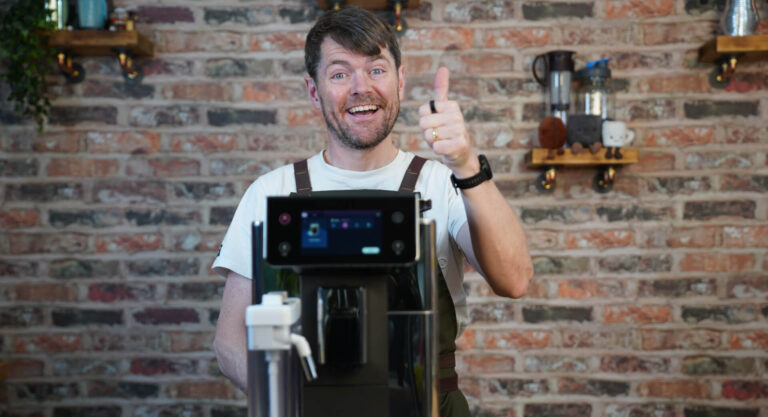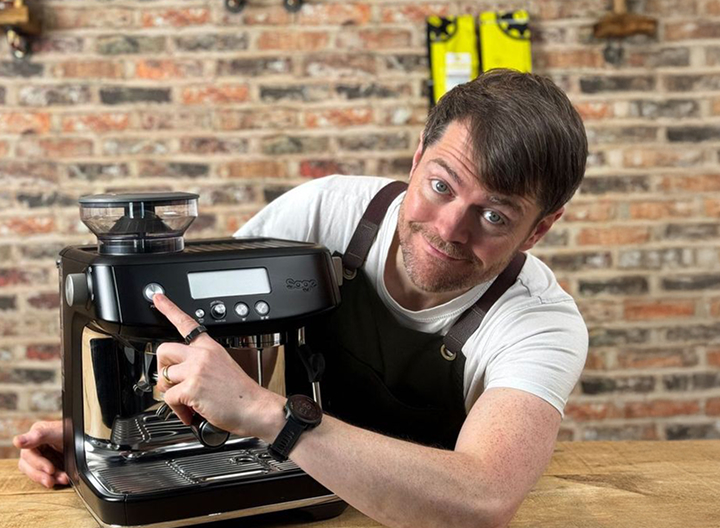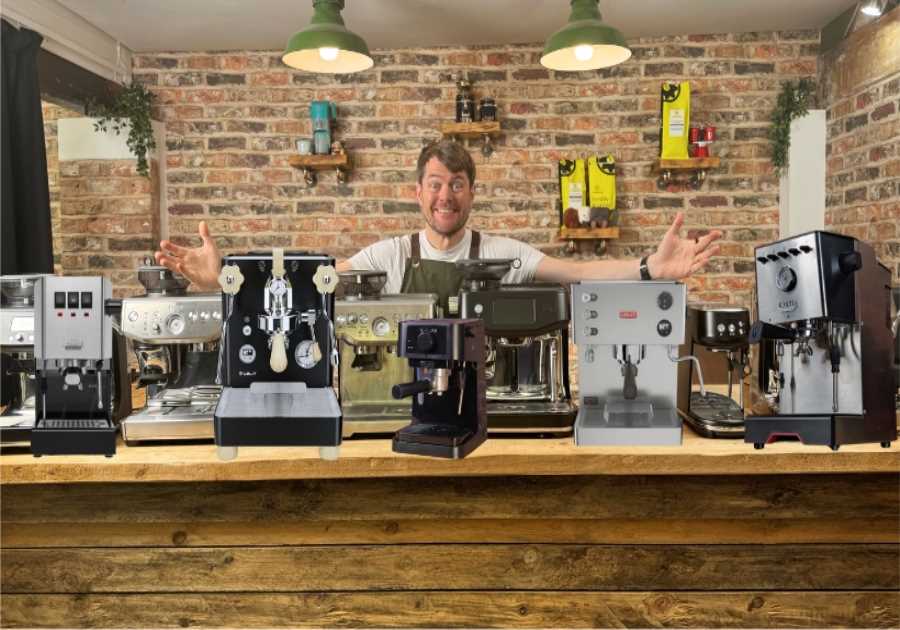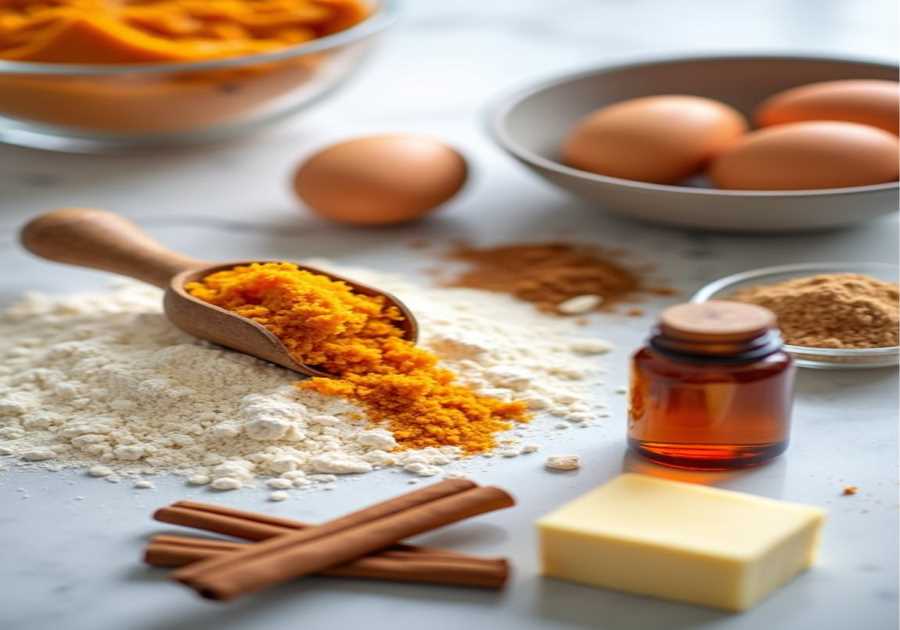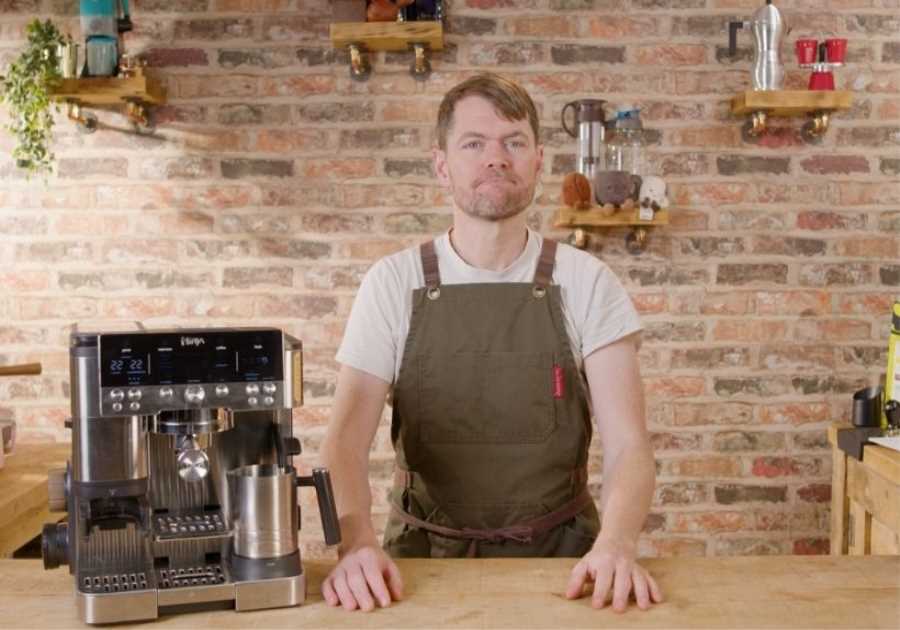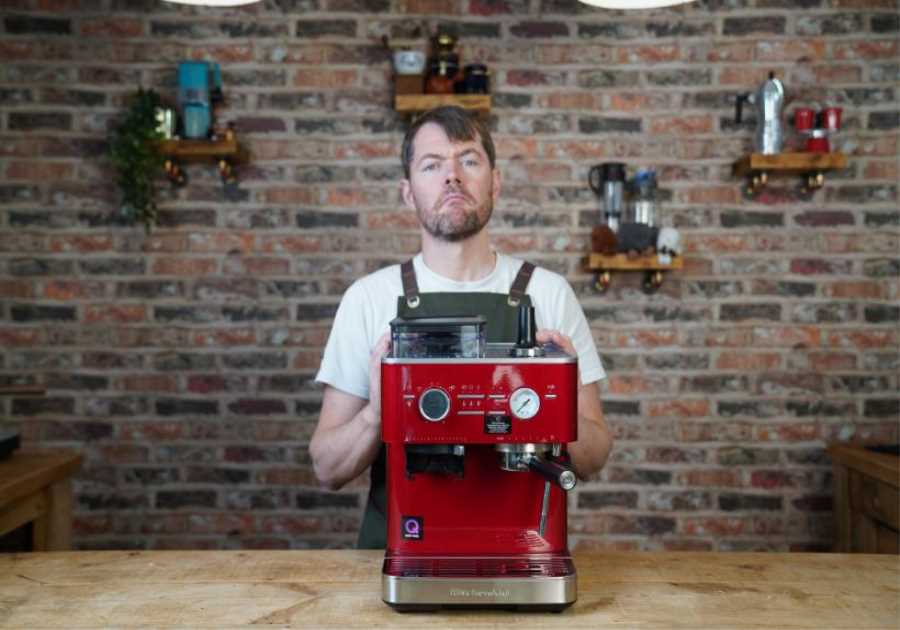If you want great espresso-based coffee at home (cappuccino, latte, flat white, Americano) with minimal faff, bean-to-cup coffee machines are a great option. Put lovely, freshly roasted whole coffee beans in the top, press a button, and skip off with a rather lovely cup of coffee. Just be careful not to spill it while you're skipping.
But finding the best bean-to-cup coffee machine for you isn't as simple as it may seem. There are a huge number of options, and it can be way more complex than most people expect.
First time here? If so, welcome. I'm Kev, my full name is “Coffee Kev”, and I can usually be found messing about with coffee machines here at coffeeblog.co.uk, and on my blog for our coffee-loving cousins across the pond at CoffeeKev.com, and if you're a real glutton for punishment, you can also watch my videos on the Coffee Kev YouTube channel.
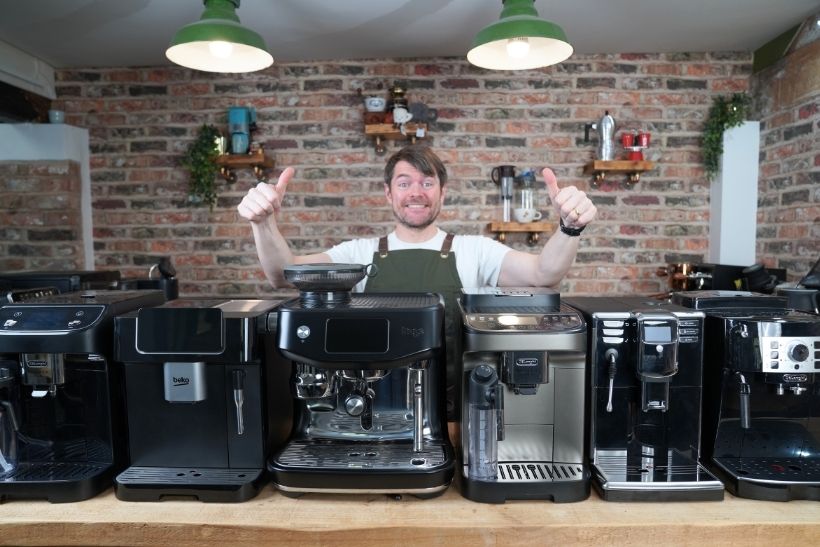
In case you were wondering, all of my reviews are 100% honest, warts ’n’ all. I never take sponsorship deals, and I’m never paid for reviews. I’m also the founder and director of coffee at cworks.co.uk—so if you’re after reasonably priced, very freshly roasted beans (usually roasted on the day of dispatch), now you know.
This isn’t a copy-paste list of machines. You’ll see my own photos and individual YouTube video reviews for most of the models here, because I’ve tested each one extensively. In fact, I’ve put dozens of machines through their paces; the ones that didn’t make the cut still get a mention in the Honourable Mentions at the end, with notes on who they might suit.
Quick Menu
- At a glance: Top picks table
- What “bean to cup” really means
- How to choose
- Best under £500
- Best under £300
- Best De’Longhi bean-to-cup
- Best Sage “bean to cup” (in-between machines)
- Best fully-automatic (one-touch)
- Honourable mentions
- How I test
- FAQs
At a Glance – Top Picks by Category
There really is no such thing as “Best”; it's a nonsense word in and of itself. This becomes clear when you apply this to other purchases. For example, can anyone tell me what the best car is? Obviously, there isn't a best, even at a particular budget; it just depends on who is asking.
So I'm considering the two main groups of people I think will be shopping in a given category, and I'm picking a winner for each (Option 1 & Option 2). It should be pretty obvious as soon as you start reading, which “Best” option would be best for you.
What Are Bean-to-Cup Machines?
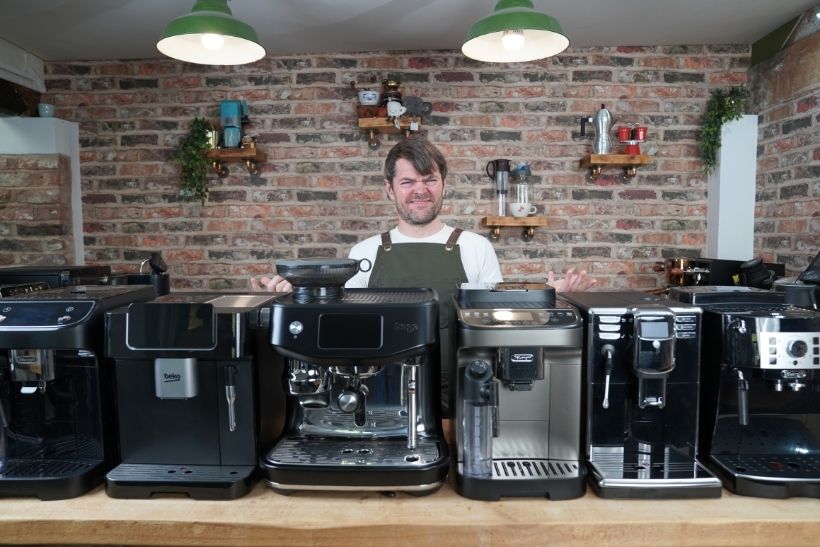
This is a good question, as some brands are blurring the lines these days. Let's be very clear about what a true bean-to-cup coffee machine is.
True bean-to-cup coffee machine: A coffee machine that makes espresso-based coffees, via a built-in grinder and an internal brewing unit.
The internal brewing unit (usually easily removable for cleaning) contains the filter basket and a gear system in order to tamp the coffee internally and to eject it into the internal bin. You put beans in the hopper, water in the tank, and just keep the drip tray and internal waste bin emptied; the machine does the rest.
The espresso these machines produce wouldn't usually be as intense in taste or body as “true” portafilter espresso, but it's very easy and convenient, and many people moving from pod coffee will find it relatively similar to what they think of as an “espresso”.
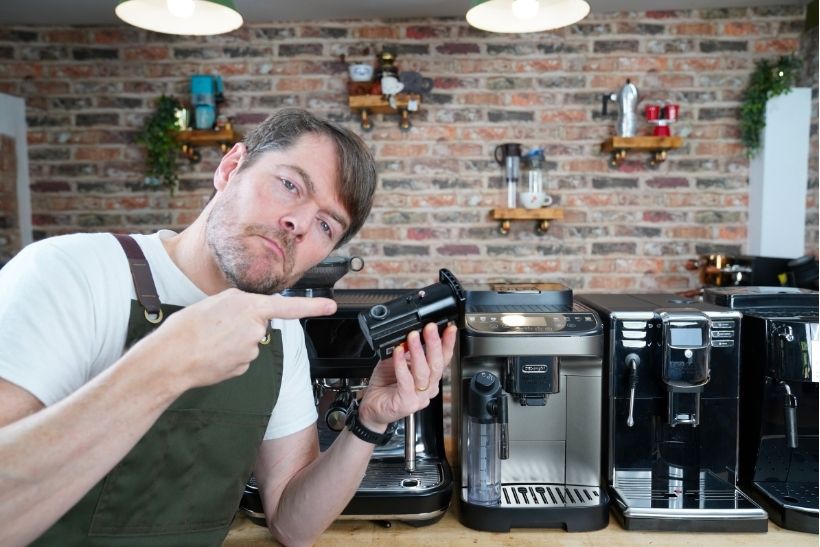
What Aren't Bean-to-cup Coffee Machines?
This is really simple: if it doesn't have an internal brewing unit, it's not a true bean-to-cup machine, it's something slightly different. A traditional portafilter machine with an integrated grinder is an integrated grinder espresso machine, not a bean-to-cup machine.
There's nothing “bean-to-cup” about the Sage Barista Express & Barista Pro, for example. They're espresso machines with a built-in grinder.
What About Sage Bean-to-Cup Coffee Machines?
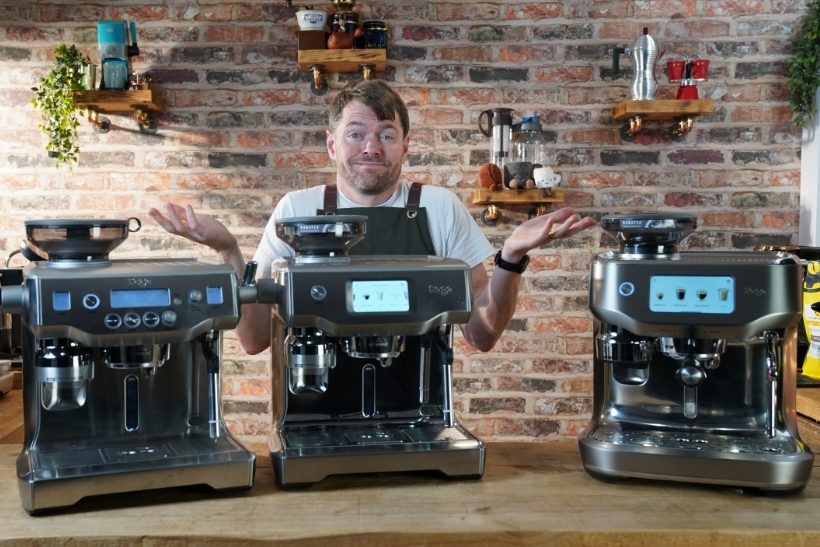
Although Sage don't make true bean-to-cup machines, they produce what could be referred to as “manual bean-to-cup” machines, or what I refer to as the “In-Between Machines”.
These kinds of machines started with the Sage Oracle & Oracle Touch (recently discontinued) and now include the Oracle Jet, Oracle Dual Boiler & the Impress range. They're portafilter espresso machines capable of great espresso, but they have built-in technology to handle dosing, tamping, and, in some cases, auto milk frothing.
Bean-to-Cup Coffee Machines Milk Frother Options
Hopefully, at this point, you're a bit clearer on what a bean-to-cup coffee machine is and isn't. Now, let's discuss the various options related to milk frothing. Most bean-to-cup machines have a milk frother, but there are different types.
Panarello Steam Wands
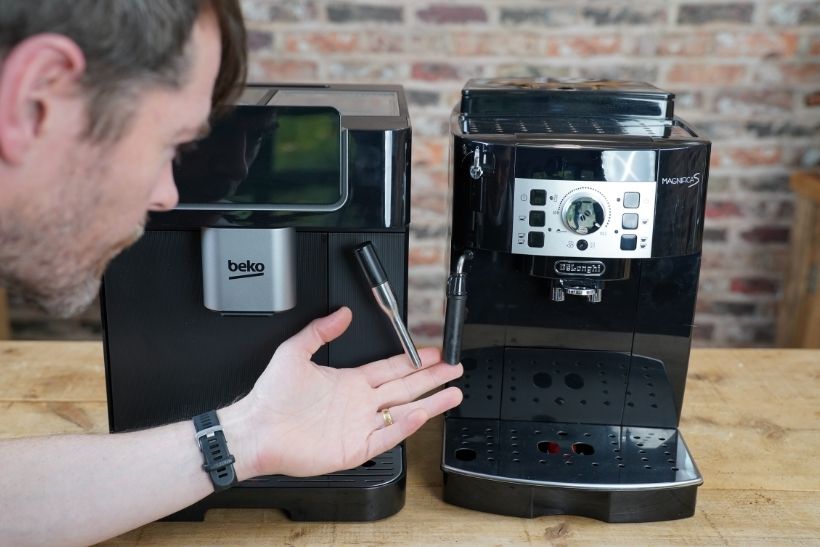
The lowest-priced bean-to-cup machines usually have a panarello steam wand —an air-intake sheath fitted to the steam pipe. They do the job, and they usually give you total control over the milk temperature, but not so much when it comes to texture, which is usually more “90's cappuccino” than speciality flat white.
You can reduce the foam by scooping the stiffest foam from the surface & pouring from one jug into another, but the milk texture produced with this kind of wand will always be tricky when it comes to pouring latte art.
One Touch Milk Carafes
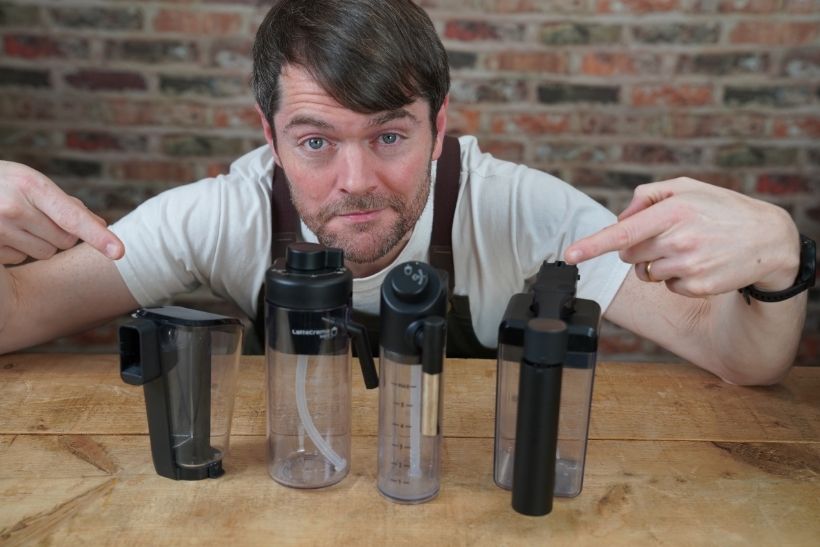
A one-touch milk carafe is a milk carafe (milk container) that has the frother inside it. You fill it with milk, and when you choose your drink, you just press one button to select your coffee (hence the “one touch”), and the machine will brew your espresso, then heat & froth the milk and deliver it into your cup (sometimes done the other way around).
These are the most convenient; they tend to give a bit more control over texture than Panarello wands. They don't give as much control over milk temperature, though; some of them have max milk temperatures that some users find disappointing (the latest DeLonghi bean-to-cup machines are the best in that regard).
You'll find some machines with something called a “cappuccinatore” frother, which is simply a carafe frother but without the carafe; instead, there's just a milk pipe that you drop into your milk.
Pro Steam Wands
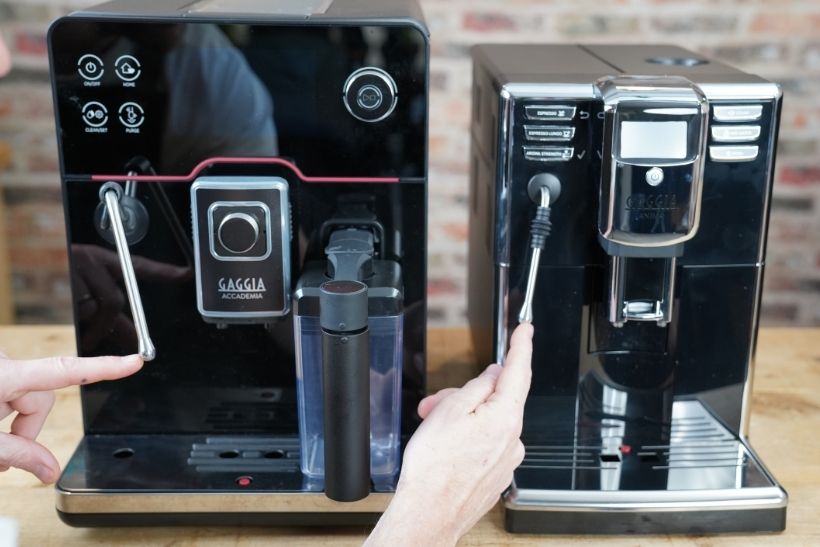
These are the kinds of steam wands you'll find on traditional espresso machines. They give ultimate control over both milk texture and temperature, but they can take a bit of getting used to at first, and they're not “one touch”; you have to steam the milk separately in a milk jug and then pour it into your espresso.
Gaggia produced the first machine of this kind a few years ago. They now have several options with pro wands, and surprisingly, none of the other brands have followed suit yet.
All of the “in-between” machines have pro steam wands and offer manual and auto milk frothing.
How to Choose a Bean-To-Cup Coffee Machine
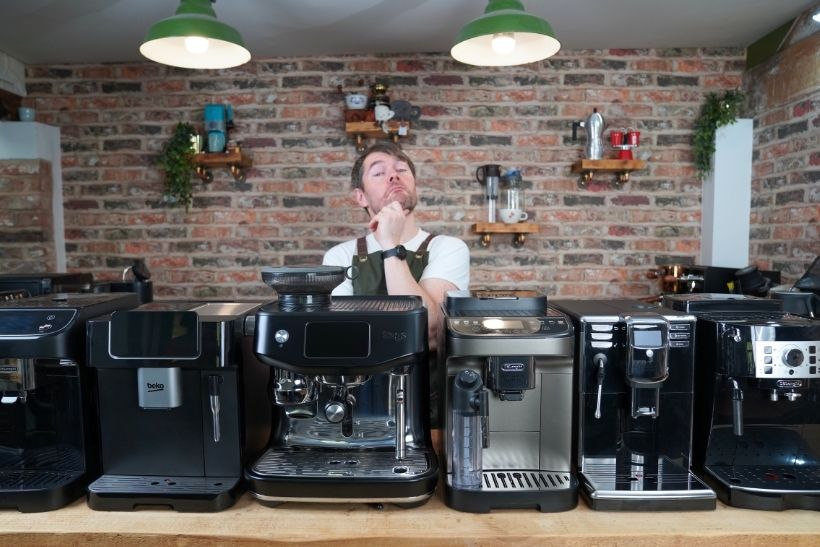
Now you're aware of all the options, how do you go about choosing the best machine for you?
Bean-to-cup & Budget
The first thing to keep in mind is that there's a huge budget range for bean-to-cup espresso machines, starting at just under £300 and going to infinity ;-). It's obvious to see why starting out at budget can be the best place to start if you don't want to waste lots of time only to have to rule out lots of machines that would be perfect if they fit your budget.
Favourite Drinks
Another way to choose is to understand which types of machines suit you based on your favourite drinks.
If you're only interested in black coffees (espresso, cafe creme, Americano), then you can completely ignore all the milk stuff and purely focus on which machine is best for the type of black coffee you mainly drink.
If you're an espresso fan, one of the “in-between” machines might be the best choice for you, as these are among the best for espresso quality.
If you're into your milk drinks, you'll probably want to rule out most of the one-touch carafe and cappuccinatore frother machines if you like them “extra hot”, as many people do. The latest De'Longhi bean-to-cup machines (Magnifica Plus, Rivelia, Eletta Explore) are among the best in this category, heating milk hotter than most of these machines.
Physical Practicality
You may as well rule out any machine that won't fit in your kitchen. If you note the machine's maximum height and keep in mind where the hopper is located and how you'll access the water tank, you can narrow your search.
Noise levels are also worth considering, especially if you have a baby or someone in the home who does night shifts (hopefully not the baby).
Most bean-to-cup machines are roughly the same in terms of noise; the loudest part is usually grinding, which is often around 60-70 decibels —a similar volume level to most hair dryers on a medium setting. There are a couple of particularly quiet machines, though, and I'll highlight these below.
Best Bean-to-Cup Coffee Machine Under £500
Option 1: De'Longhi Magnifica Evo Next
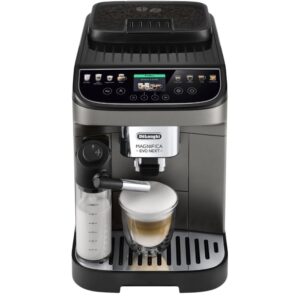
Get An EXTRA 10% off at De'LonghiCheck Price - Amazon
Best Under £500 For Tech-Savvy Coffee Drinkers
DeLonghi knows what they're doing, and I reckon they've styled the Evo Next for the modern coffee drinker looking for a sleek, user-friendly experience. This isn't everyone; if it's not you, you'll probably want to check out Option 2 down below.
I think a large (and growing) percentage of people reading this will be in the “I like modern-looking touch-screen machines” camp, and if that is you, I think the De'Longhi Magnifica Evo Next is most likely the machine for you, for around £ 500.
Features
- Dimensions: 24 cm wide × 44 cm deep × 36 cm tall
- Heater: Thermoblock
- Water Tank: 1.8 litres, removable from the front
- Milk Steaming: LatteCrema Hot one-touch milk carafe
- Grind Settings: 13
- Strength Settings: 4
- True Double Shots? No
- Grinder Bypass Chute for Pre-Ground Coffee? Yes
- Maximum Cup Height: 14 cm
- Grounds Bin Capacity: 14 coffees
My Observations
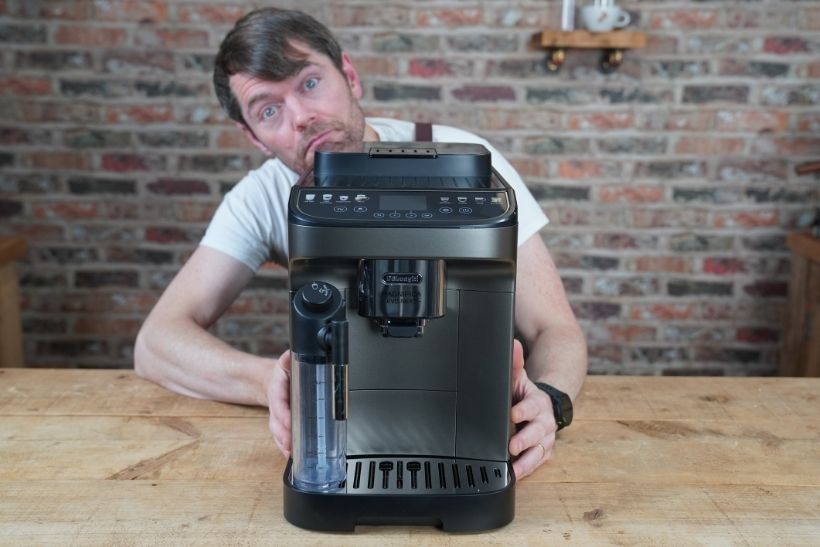
The Magnifica Evo Next feels in some ways like De’Longhi's closest current machine to the legendary “ECAM 4200”, which was the best-selling bean-to-cup machine in the UK for several years.
It's far more modern and compact, and has the latest version of De'Longhi's interface, but it seems they've really nailed the brief with the Evo Next, as they clearly did with the ECAM 4200, when it comes to achieving a good balance between performance & value for money.
As I've come to expect from DeLonghi machines, it's solid, sturdy & yes, it's mainly plastic, but it seems very well made. The interface is easy to use, and it performs really well in all areas. There are no real red flags with this machine.
It's capable of quite intense espresso as far as bean-to-cup machines go. It doesn't do a true double shot in terms of double the espresso from double the ground coffee, but a “2 x espresso” is made with roughly 15g of beans, so it's not the same as with some of the earlier DeLonghi machines, where a double shot was made with only a gram or two more ground coffee.
The milk temperature the carafe produces is the hottest I've had so far from a bean-to-cup milk carafe, in the high 60s, which is a bit too hot in my personal opinion, but some people will love that!
What I Like
- Compact: Small footprint, but also only 36cm tall, and the water tank is pulled out from the front
- Nice looking: Kitchen-friendly design that I think will fit quite well in most modern kitchens
- Intense espresso: Capable of intense espresso as far as bean-to-cup machines go
- User profiles: 3 separately customizable user profiles, a relatively premium bean-to-cup machine feature
- Easy interface: 2.4″ colour TFT display plus very convenient shortcuts to drinks
I think they've nailed it with all the good stuff this machine has going for it. No issues with espresso strength or temperature, or with milk temperature. Milk texture from the carafe isn't bad, not quite as good as the carafe on the Magnifica Plus, where microfoam is concerned, but fairly standard for a one-touch carafe.
I think having 3 user profiles is suitable for a machine at this price (I'd prefer 4, I like even numbers), the interface is very slick, and I love the row of milk drinks and black coffees, it makes it very fast & convenient to choose your coffee.
What I Like Less
- Small milk carafe: 280ml max, some people find it a bit on the small side.
- Not true double shots: This isn't a massive deal, I just find it slightly irritating that a double shot isn't double the dose and espresso vs a single shot
Final Verdict
I think DeLonghi have done a really good job here when it comes to striking the balance between features & price.
They've gone as far as they probably needed to for around £500, and De'Longhi have such a huge range that if you do need a specific feature that this machine doesn't have, you'll probably find you can get that by investing slightly more in one of their slightly more advanced machines.
The De’Longhi Magnifica Evo Next is probably the best choice for most people at this price point. It's very convenient, the cup quality is about as good as any bean-to-cup machine (even those costing hundreds more), the interface is very slick & easy to use, and DeLonghi have an excellent record for producing very reliable machines.
Option 2: Gaggia Anima
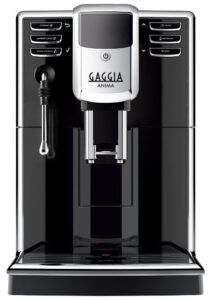
Check Price - Gaggia DirectCheck Price Amazon
Best Under £500 For Old-School Simplicity
If you rolled your eyes when you saw “tech-savvy” in relation to the people I think the Magnifica Next is best-suited to, and your idea of the perfect smartphone would be the BlackBerry if they still made them (and that's me by the way!), then the Gaggia Anima is probably made for you.
Personally, I loved the BlackBerry, and if there was a modern smartphone with proper buttons and a smaller screen, I'd switch to that in a heartbeat. If you're in the same camp as me there, you'll probably appreciate the more old-school tactile buttons on the Anima, though it's not the only thing it has to offer.
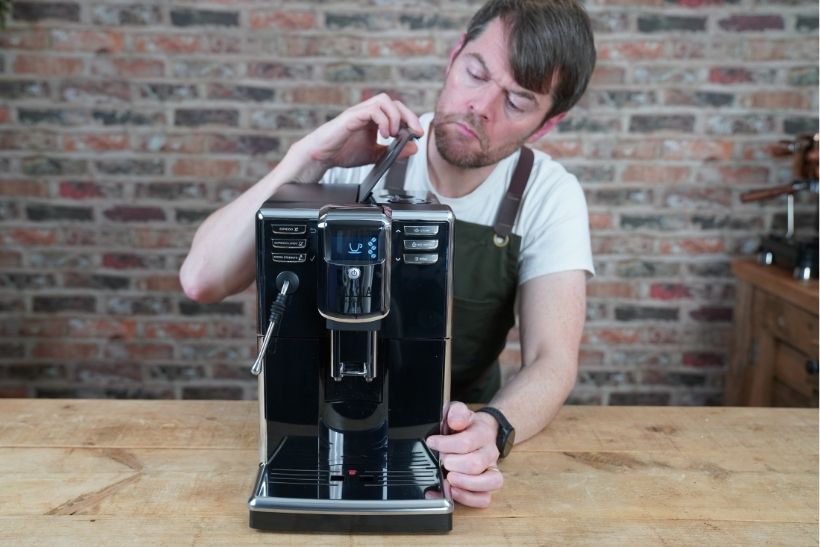
Features:
- Dimensions: 22.1cm wide x 43cm deep x 34cm tall
- Heater: Thermoblock
- Water tank: 1.8 Litre (top filling)
- Milk steaming: Panarello steam wand (other milk options available)
- Grind settings: 5
- Strength settings: 5
- True double shots?: Yes
- Grinder bypass chute for pre-ground coffee?: Yes
- Maximum Cup Height: 15 cm
- Grounds bin capacity: 16 coffees
My Observations:
The Gaggia Anima is a slim, solid, simple-to-use bean-to-cup espresso machine with very intuitive & straightforward tactile button-press controls.
I don't want to give the impression that it's some kind of relic ;-). It's a modern-looking machine with an LCD screen, but it's a more “old-school” design with tactile buttons and really simple, intuitive controls.
For example:
- Re-program coffee volumes: Press and hold the relevant button to enter programming mode.
- Single or double shots: Tap the button once for single, twice for double (grinds & pulls two back-to-back single shots)
- Dose setting: Tap the “Aroma/strength” button to toggle through the bean settings, which range from 7-11g for a single shot (14-22g for a double)
Gaggia bean-to-cup coffee machines are hard to beat when it comes to transparency and flexibility over dose (amount of ground coffee) and volume (amount of espresso).
It's usually quite difficult to figure out how much coffee a machine is grinding, and adjusting the coffee volume to your liking can also be a bit of a challenge. With Gaggia bean-to-cup machines, you can simply choose the bean setting to get the required dose, then press and hold the shot button in programming mode to reset the volume.
Having various milk options also adds to the flexibility. I should probably quickly list the various models and how they differ:
- Anima: Panarello steam wand
- Barista Plus: Pro steam wand
- Deluxe: Capuccinatore frother
- Class: One-touch milk carafe
- Prestige: One-touch milk carafe & slightly fancier finish
What I Like:
- True double shots. As with all the Gaggia bean to cup machines, a double shot means a double shot
- Big max dose. Thanks to the “double-tap for double shot” feature, it'll produce a big, strong espresso
- Easy dose options. Just choose the number of beans. 1 bean: 7g, 2:8g, 3:9g, 4:10g, 5:11g
- Compact. About as slim as they come at 22cm wide
- Reliable. It's one of the least tech-heavy machines on the market, less to go wrong
- Tactile controls. A nice, solid button press for espresso, steam & hot water
- Simple. Very simple to operate and to re-program shot volumes
- Milk Options. One machine, but four frother options, including Pro steam wand
What I Like Less:
- Top-fill water tank. Can be a blessing or a curse
- No Hopper Seal. A gasket on the hopper lid (as on the Gaggia Brera) would make the grinding slightly quieter
Gaggia Anima – Final Verdict
If you're looking for the best bean-to-cup coffee machine under £500, you're mainly focused on reliability & value for money, and you prefer simple button controls over flashy touch interfaces, I think you'll struggle to find one at this price that suits you better.
It's also helpful that there are various versions when it comes to milk; if you want to pour latte art, for example, you'll probably want to have a look at the Barista Plus version.
| Test Results | De'Longhi Magnifica Evo Next | Gaggia Anima Barista Plus |
|---|---|---|
| Heat-up time (from cold) | <40 seconds | <40 seconds |
| Max coffee dose | Single 12g | double: 15g | Single 11g | double: 22g |
| Steam power (170ml. 0-60 °C) | ~65 seconds including heatup | ~45 seconds plus 5-20 sec ready time |
| Hot water power (200 ml). | ~50 seconds | ~60 seconds |
| Max milk temperature~ | ~ 67 °C | N/A (steam wand, no max temp) |
| Espresso temperature | ~ 70 °C | ~ 78 °C |
| Hot water temperature | ~ 88°C | ~ 88 °C |
| Noise: | Grinding ~ 63dB | Pump ~ 45 dB | Grinding ~ 65dB | Pump ~ 50 dB |
Best Bean-to-Cup Coffee Machine Under £300
Option 1: De'Longhi Magnifica S
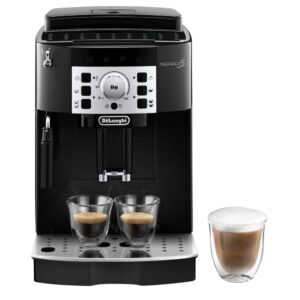
Get An EXTRA 10% off at De'LonghiCheck Price - Amazon
Best Under £300 for Peace of Mind
DeLonghi is the largest coffee machine manufacturer on the planet, and they're known for producing great-value coffee machines that are usually fault-free and remain reliable for several years. So they're a very safe option.
There are other sub-£300 machines that may appear to offer more, but what they can't usually offer is the peace of mind that comes from buying a very tried & tested machine from a very well-known brand.
The Magnifica S is a very tried & tested machine from a huge coffee machine brand, so if peace of mind is high on your list of importance, you'd like as little chance as possible of having a fault straight out of the box or a few months down the line, the Magnifica S is probably the bean to cup coffee machine for you at this price tag.
Features
- Dimensions: 24 cm wide × 41 cm deep × 35.5 cm tall
- Heater: Thermoblock
- Water Tank: 1.8 litres, removable from the front
- Milk Steaming: Manual Panarello steam wand
- Grind Settings: 13
- Strength Settings: 5
- True Double Shots? No
- Grinder Bypass Chute for Pre-Ground Coffee? Yes
- Maximum Cup Height: 14 cm
- Grounds Bin Capacity: 14 coffees
My Observations
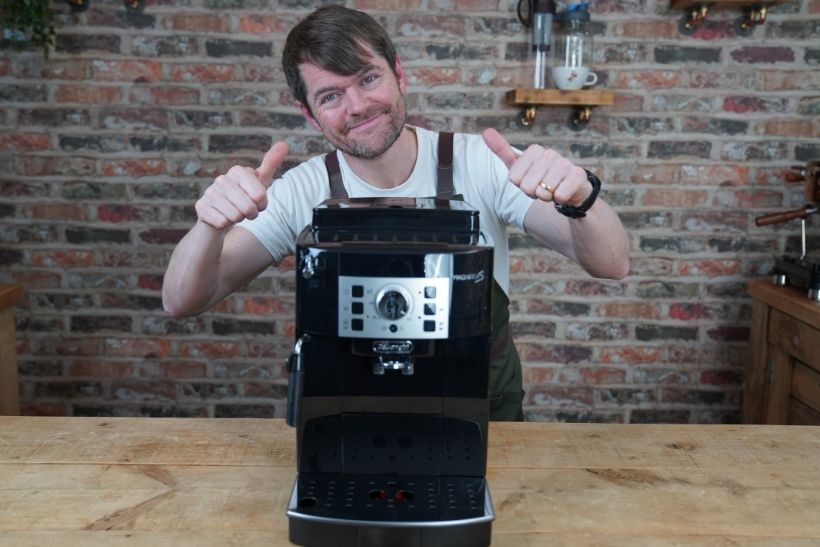
The Magnifica S initially took the reins from the Magnifica ECAM 4200 as the best-selling DeLonghi bean-to-cup machine, and it has gradually become available at increasingly better prices as new models have been released.
There are flashier-looking alternatives at a similar price, but most of these are more of an unknown entity (often both the machine and the brand). When you buy the Magnifica S, you can rest assured you'll have trouble-free coffee-making for years, with far fewer problems.
The Magnifica S also features De'Longhi's tactile controls from the original Magnifica line-up. No touchscreens, just dials and buttons—a more “hands on” experience—so it'll also appeal to the same kind of user who would prefer the Gaggia Anima, but for a couple of hundred quid less.
What I Like
- Built to last: Simple components & interface, known to run for many years with minimal issues.
- Compact: Small footprint & fit under most kitchen units (front access to water tank, too).
- Panarello steam wand: Easy to produce old-school foam, and you can remove it to produce microfoam
- Simple interface: No menus or screens to navigate — just buttons and a dial.
- Easy to clean: Very simple cleaning cycles, and the panarello simply pulls off to be washed
- Same cup quality as double the price: The coffee-making components are the same as in much more expensive DeLonghi bean-to-cup machines
I do think there's a lot to like here, for the money. It'll produce the same coffee quality as much more expensive DeLonghi coffee machines (mainly the same components for coffee-making), and it's a tried & tested, reliable machine, so there's no “taking a punt” here.
What I Like Less
- No true double shot: You can work around this; it's not a big deal. I just find it irritating
- Basic controls: This is only a negative if you're not in the “I prefer old-school controls” camp
- Plastic finish: It's what I refer to as plastic fantastic, but this is one of the reasons it's so low-cost
There's no real reason to be put off by not having a true double shot. All this means is that you have to mess around with the intensity & volume to get a bigger espresso that is the same as a single-cup shot, just bigger.
If the basic controls put you off, then see the alternative, or if you want to stick to De'Longhi, consider raiding another piggy bank for another hundred quid or so if that's possible.
Final Verdict
This is a cracking little bean-to-cup machine for the money. If you just want the best performance and reliability you can get from a bean-to-cup coffee machine for under £300, this is probably it.
Option 2: Beko CaffeExperto
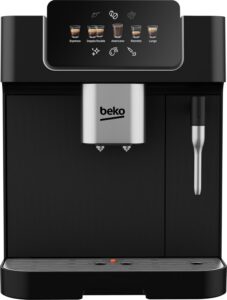
Best Touch Screen Machine Under £300
If you're looking for a modern, touchscreen bean-to-cup coffee machine under £300, you might just fall in love with the Beko CaffeExperto, especially if you regularly switch to decaf or other beans you'd usually buy pre-ground. It may sound like one of Harry Potter's spells, but it is, in fact, a (pretty magical, to be fair) bean-to-cup coffee machine.
Features
- Dimensions: 27.5 cm wide × 40 cm deep × 34 cm tall (36 at the very front including screen)
- Heater: Thermoblock
- Water Tank: 2 litres, rear accessed
- Milk Steaming: Panarello wand (simple hack to go pro)
- Grind Settings: 13
- True Double Shots? Yes
- Grinder Bypass Chute for Pre-Ground Coffee? Yes (you can create your own pre-ground too!)
- Maximum Cup Height: 14cm
- Grounds Bin Capacity: 10 (very easy access)
My Observations
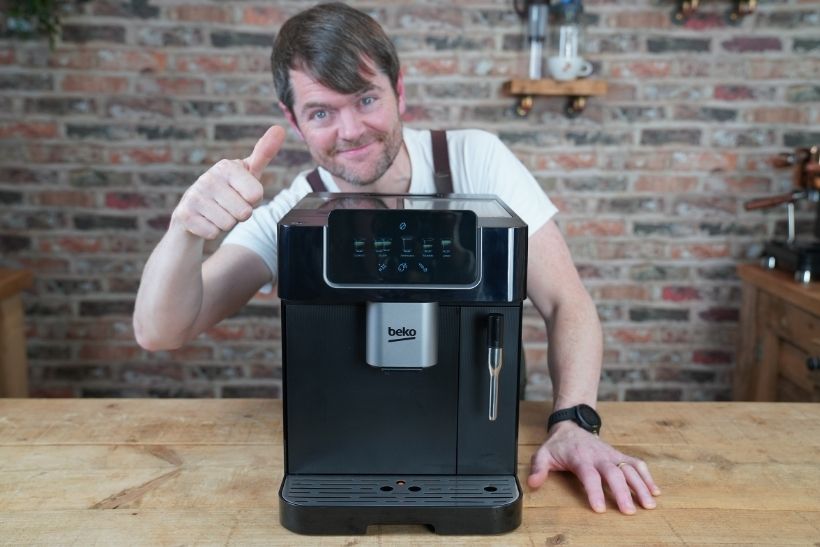
Knowing Beko, I expected this machine to be “OK”, but I was just expecting a cheap, no-frills bean-to-cup coffee machine. To say I was pleasantly surprised would be an understatement! For me, this is head and shoulders above many more expensive machines in terms of overall build quality and performance.
Take the Philips 5400 for example (please, take it!). The Beko feels way better quality to me, and the espresso is a lot stronger (8-10 tds vs around 3-4 tds from my testing).
It's plastic, as to be expected, but there's nothing flimsy about it. Everything feels solid, including opening and closing the service door and removing and reseating the hopper lid and water tank. The touch screen looks like a neat little tablet, and it's bright, responsive, and very intuitive.
Strength settings are simply 2 bean settings; espresso and hot water volumes are easy to reprogram. The espresso is fairly strong for a bean-to-cup machine, and it has all the drinks you'd expect, except for Americano, which isn't quite what I'd expect.
Steaming milk is particularly smart. You tap the steam icon once to purge and heat, then tap it again once you're ready to start steaming. You can also very simply cover the air intake hole at the top of the wand to use it like a pro steam wand.
Pre-Grind Your Own Decaf. Unlike many bean-to-cup machines, when you tap the shot button again to cancel the shot after grinding, it dumps the dry grounds into the internal drawer.
So if you clean and dry the drawer first, you can use this as a quick and simple hack to pre-grind your own. This means you can buy your decaf or half-caf 50/50 freshly roasted as whole beans, which stay fresh much longer than pre-ground coffee.
Other Surprising Features:
- True double shot: Select double espresso, it grinds and brews two back-to-back single shots
- I started, so I'll finish: If you run low on water, top up the tank, the shot continues after!
- Barista lights: Lights that put your coffee in the spotlight while you're using the machine. Surprising feature on such a budget bean-to-cup machine
- Hot milk: Not only is this relatively quick to steam milk, the cut-off is at about 90℃, so if you want to burn your milk, go ahead

- Intense espresso: The espresso from the Beko is among the most intense I've experienced from an auto bean-to-cup
Espresso intensity: In addition to tasting, I also measure TDS on all machines using the DI Fluid R2 refractometer. I'm not giving the data for each machine as it would make this post too nerdy ;-), but at the max intensity, the Beko CafeExperto has produced more intense espresso in terms of TDS than most other machines I've tested, including the Magnifica Plus.
This doesn't mean it can only produce really intense espresso; you can control it. It just means that if you're going for as close to traditional espresso as possible, this machine is one of the better options. The only other true, automatic bean-to-cup machine (excluding Sage or Ninja machines) capable of a similar intensity is the DeLonghi Magnifica Next.
What I Like
- Value: A lot of machine for the money in terms of overall quality & performance
- Simple: One of the easiest-to-use machines I've used
- Size: Very short for a bean-to-cup machine
- Pre-ground hack: You can do this on a number of bean-to-cup machines, but it's not usually this fast or quick, and it's often slightly damp
- Strong espresso: As noted above
- Steaming milk: It heats up and purges, and then waits for you to tap it again to start, very smart
What I Like Less
- Americano: This is a very long espresso, that's not Americano. For an Americano, make an espresso, then tap the hot water icon.
- Less peace of mind: Beko are a known kitchen appliance brand, but they're not particularly well-known for coffee machines. It does come with a 2-year warranty.
Beko CaffeExperto – Final Verdict
If you're looking for the best touch-screen bean-to-cup coffee machine under £300. It's among the best bean-to-cup machines at this price, touch screen or not. In fact, it punches way above its weight, flooring some of the machines costing £500+. Beko aren't a well-known coffee machine brand, and the machine itself isn't particularly tried & tested, so there's some risk in the long-term, but it does come with a two-year warranty.
| Test Results | DeLonghi Magnifica S | Beko CaffeExperto |
|---|---|---|
| Heat-up time (from cold) | ~50 seconds | ~30 seconds |
| Max coffee dose | Single 10g | double: 12.5g | Single: 10g |double 12g |
| Steam power (170ml. 0-60 °C) | ~50 seconds, plus 20 sec heatup from cold | ~52 seconds plus 20 sec heatup from cold |
| Hot water power (200 ml). | ~45 seconds | ~54 seconds |
| Max milk temperature | N/A (steam wand, no max temp) | ~90°C (90-second max steaming time) |
| Coffee temperature | ~75°C | ~70°C |
| Hot water temperature | ~80°C | ~80°C |
| Noise: | Grinding ~60dB | Pump ~ 50 dB | Grinding ~65dB | Pump ~45dB |
Best De'Longhi Bean-to-Cup Coffee Machines
Option 1: De'Longhi Magnifica Plus
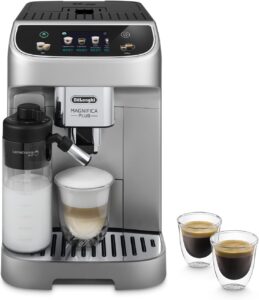
Get An EXTRA 10% off at De'LonghiCheck Price - Amazon
Best for Set & Forget Use
The Magnifica Plus is the latest generation of De'Longhi’s hugely popular Magnifica line. If you just want to load in your favourite beans & top up when you run out, this is probably the best Delonghi bean-to-cup coffee machine for this kind of use, without spending silly money.
Features
- Dimensions: 24 cm wide × 44 cm deep × 35 cm tall
- Heater: Thermoblock
- Water Tank: 1.8 litre, front removable
- Milk System: LatteCrema Hot (auto milk carafe)
- Grind Settings: 13
- Strength Settings: 5
- True Double Shots? Yes
- Grinder Bypass Chute for Pre-Ground Coffee? Yes
- Maximum Cup Height: 13 cm
- Grounds Bin Capacity: 14 coffees
My Observations
DeLonghi’s long-running Magnifica platform is really the perfect bean-to-cup coffee machine for “normal” coffee machine use.
By normal, I mean that you fill the hopper with your daily driver beans, and if you want anything different in the meantime: decaf, half-caff, or a different-tasting single origin vs your house espresso blend, you'd buy pre-ground and spoon this into the grinder bypass chute.
The Magnifica Plus represents the most polished version of this lineup so far, and it's definitely one of my favourite DeLonghi bean-to-cup machines. When pushed, I'll usually respond that my favourite from DeLonghi is either the Magnifica Plus, or the Rivelia, depending on who is asking.
What I Like
- Big maximum dose: It'll grind up to 17g in one dose!
- Shortcuts: It's a really simple interface, and the shortcuts for black coffees & milkies are very handy
- MY setting: Being able to set the volumes on the fly is a VERY good feature
- Milk Temperature: The hottest milk I've encountered from a one-touch milk carafe
- Milk Texture: Among the best milk texture I've experienced from a one-touch milk carafe
- Best flat whites: I've not had closer to a “true” flat white from another bean-to-cup machine
To clarify my best flat whites comment: flat whites from a bean-to-cup machine are usually cappuccinos or lattes. To closely resemble a flat white, they'd need to be more intense, & the milk texture would need to be micro-foam, not old-school cappuccino foam.
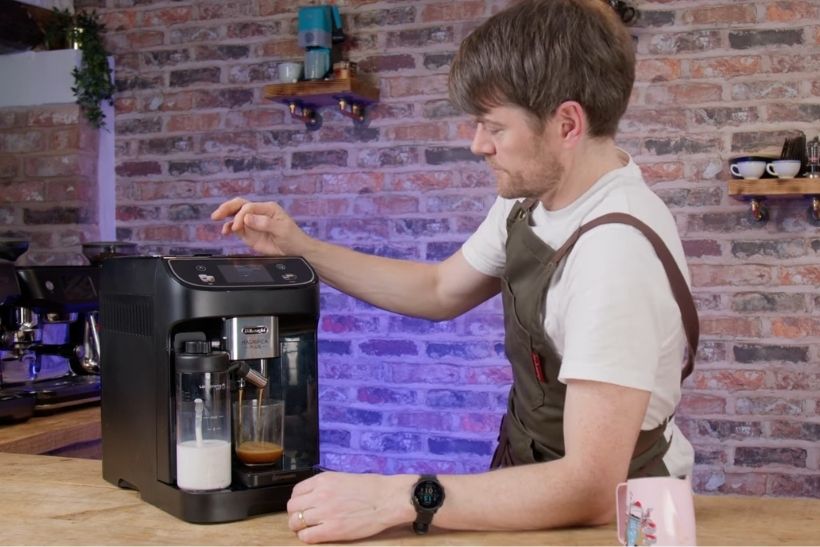
The Magnifica Plus will use a dose as big as about 17g, which is the same kind of dose used for double shots on traditional espresso machines. Using the MY setting, it's simple to control the volume, to produce a 40-50 gram shot.
The milk (on the unit I have, at least) ends up at about 60-62°C, which is around the perfect milk temp in my opinion, and the texture, if you turn the froth setting dial down slightly, is really good. Yeah, I can do better with a pro steam wand, but for a one-touch carafe, it's very impressive.
What I Like Less
- Iced coffees: An iced coffee setting, which entails a standard hot espresso and an instruction to add ice, is a bit daft
- Upside-down cappuccino: This is latte macchiato, in my opinion.
- No latte: Only latte macchiato, which is almost the same as the cappuccino option
- Single & Double Confusion: It's fine once you know this, but the relationship between a single and a double shot isn't as you may expect
My dislikes are relatively petty, to be honest. The “Iced coffee” thing is true of most of DeLonghi's latest machines; they offer “iced coffees” by telling you to add ice, and I can't help but take the mickey as a result ;-).
Cappuccino on the Magnifica Plus is made with milk first, resulting in a layered drink that tastes like hot milk until you get to the coffee. You could always give it a stir to partially integrate the milk & espresso, or you could just use the flat white setting for cappuccino and latte, and tweak the intensity (espresso-to-milk ratio) and the froth level depending on what you want to drink.
A double or “2 cup” espresso is made with 14-17g of beans, depending on the strength setting. A single or “1 cup” is made with 12-14g. I don't think DeLonghi have a broken calculator ;-), I suspect they just don't think about singles and doubles the way most people do.
Final Verdict
The Magnifica Plus, in my opinion, is the best of the latest DeLonghi bean-to-cup machines for most “normal” coffee drinkers, especially for those who're fond of “true” flat whites.
If you're only wanting hot coffees, you're not fussed about regularly switching beans, and you don't want to wander into the thousand pounds and up territory for machines like the Eletta Explore or the PrimaDonna range, the Magnifica Plus is probably your best choice.
Option 2: De'Longhi Rivelia
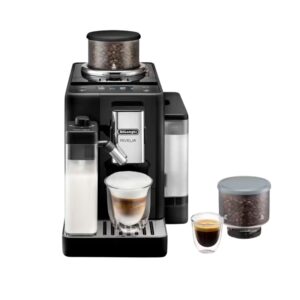
Get An EXTRA 10% off at De'LonghiCheck Price - Amazon
Best for Switching Beans
The De'Longhi Rivelia took me by surprise when I first received it. I knew it had two hoppers, but I wasn't expecting De'Longhi to answer the “what to do about Decaf” question, just like that, and they did. Not just decaf, but when it comes to switching from one bean to the next, mid-hopper, the Rivelia is the first bean-to-cup coffee machine to properly resolve this issue.
This isn't all the Rivelia has going for it. Even without the dual hoppers & switch mode, the Rivelia is a DeLonghi machine with lots going for it, but with this unique feature, this is really the ultimate bean-to-cup coffee machine for anyone who likes to regularly switch beans who doesn't want to compromise on taste by using pre-ground.
Features
- Dimensions: 24 cm wide × 45 cm deep × 38 cm tall
- Heater: Thermoblock
- Water Tank: 1.4 litres
- Milk System: LatteCrema Hot (auto milk carafe)
- Grind Settings: 13
- True Double Shots? Yes!
- Dual Bean Hopper System: Yes – quick-swap system with sensors
- Grinder Bypass Chute for Pre-Ground Coffee? Yes
- Maximum Cup Height: 14 cm
- Grounds Bin Capacity: 14 coffees
My Observations
So you fill your hopper with your favourite blend, and if you're me, that would be cworks Chocolate Brownie Blend, of course :-). Now, it's a bit later in the day and you fancy switching over to Cworks Chocolate Fudgecake Half Caffeine, or maybe to Milk Chocolate & Caramel Decaf Honduras.
Do you really want to opt for pre-ground coffee? In my opinion, that defeats the purpose of owning a coffee machine with a built-in grinder.
Other brands have tried to deal with this. Melitta has the TS Smart, with “dual hoppers”, but it's just one split hopper with two halves, feeding one grinder. DeLonghi (also Jura and Siemens) have found a winning solution for this in the past with dual-grinder machines like the Maestosa, which is perfect if you have a spare couple of grand.
The Rivelia, though, is the first reasonably priced home bean-to-cup coffee machine with a proper solution for switching beans, which works way better than I'd initially expected!
How Switch Mode Works
- Unlock the hopper. Approx. 9 grams of beans remain on top of the burrs.
- Make your choice. Do you make a coffee with these beans, or purge them?
- Switch hoppers. You're ready to go. Just do this again to switch back.
So you don't even have to waste beans; you just make your last coffee in switch mode, which you go into just by unlocking the hopper.
What I Like
- Dual hopper & switch mode: A proper, workable solution for switching beans mid-hopper
- Actual double shot: When you select a 2x espresso, it grinds & pulls two back-to-back shots
- Extra shot: If you need a boost, you can toggle the “extra shot” on, and you can save that into your drink profile too
- Extra coffee: You have a small window of opportunity to select “extra coffee” to keep going until you've got the volume you were hoping for
- Actual iced coffees: You can buy the latte crema cool carafe to unlock that option if you want it. It doesn't come bundled with the machine, though
- Long coffee: I'm not sure they got the name right for this coffee, but it's slightly different & I do quite like it
Just to explain the long coffee: there's already lungo on the menu, so I was confused by “Long”, and it turned out to be a bigger ratio double shot made by pulsing and pausing. What you end up with is a big, fairly intense black coffee, somewhere between an Americano, café crème & filter coffee.
What I Like Less
- LatteCrema cold isn't included: I think it's a shame it doesn't come bundled with the cold carafe
- Small water tank: Not a massive deal, it's easy to access, but I think some people would prefer a bigger water tank
- Tiptoes may be required: Top-mounted display, a challenge to see if you're vertically challenged & have high worktops
Final Verdict
If you're regularly switching beans mid-bag, for example, from full caff to half caff or decaf, or from your house blend to a slightly funkier single origin, I think you'll probably struggle to find a bean-to-cup coffee machine that will suit you better than the Rivelia.
| Test Results | Magnifica Plus | Rivelia |
|---|---|---|
| Heat-up time (from cold) | <40 seconds | ~ seconds |
| Max coffee dose | Single 12.5g | double: 17g | Single 10g | double: 12g |
| Steam power (170ml) | ~ 55 seconds | ~ 55 seconds |
| Hot water power (200 ml). | ~45 seconds | ~45 seconds |
| Max milk temperature | 67 °C | 67 °C |
| Coffee temperature | ~80 °C | ~80 °C |
| Hot water temperature | ~80°C | ~80°C |
| Noise: | Grinding ~ 62dB | Pump ~ 42 dB | Grinding ~ 60dB | Pump ~ 45 dB |
Best Sage “Bean to Cup” – In-Between Machines
If you're looking for a Sage bean-to-cup coffee machine, guess what? They don't exist ;-).
Bean to cup is a popular phrase, and these days, everything with a grinder is being called a “bean to cup machine” as a result, but Sage makes portafilter espresso machines; none of them have internal brewing units.
They do, however, make what I refer to as “In-Between” machines. These are machines that sit in between traditional portafilter espresso machines & fully automatic bean-to-cup machines, offering true barista cup quality with fully automatic bean-to-cup convenience.
Sage started this category with the Oracle, and then the Oracle Touch, which have both recently been discontinued to make way for the new Oracle Jet & Oracle Dual Boiler. If you don't want to compromise on either cup quality or convenience, one of these machines may be perfect for you.
Option 1: Sage Barista Touch Impress
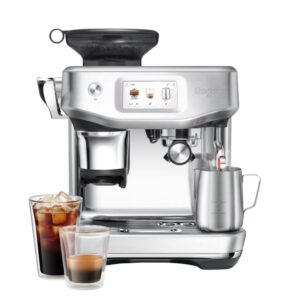
Get An EXTRA 12.5% off at SageCheck Price - Amazon
Best for Value for Money
The Barista Touch Impress is Sage’s most affordable of Sage's “in-between” machines, and if we're focusing purely on performance, I think it's by far their best for value for money.
There are a few things it doesn't have going for it that the much more expensive Oracle Dual Boiler & Oracle Jet do, and I'll list these shortly, but many people will probably determine that these features aren't worth the big budget stretch.
Features
- Dimensions: 35 cm wide × 34 cm deep × 41 cm tall
- Heater: Single ThermoJet
- Grinder: Integrated Baratza European conical burrs
- Grind Settings: 30 stepped external + 10 internal
- Portafilter: 54 mm stainless steel (single & double baskets, standard + pressurised)
- Milk System: MilQ hands-free microfoam with 4 presets, plus manual frothing
- Espresso Workflow: Fully assisted dosing & tamping
- Menu Drinks: Espresso, Double Espresso, Americano, Latte, Café Crème, Cappuccino, Flat White, Babyccino, Hot Chocolate, Tea
- Custom Drinks: 8 programmable slots
- Water Tank: 2 L, top-rear accessed with quick-release handle, includes filter
- Drip Tray: Large capacity with hidden storage space
- True Double Shots? Yes
- Maximum Cup Height: ~12 cm
My Observations
The Touch Impress has been one of Sage's biggest gamechangers since they launched the Oracle. The combination of the dose sensor & calibrated tamp lever (which together is known as the Puck Impress system), barista assistance (grind size assistance), and all the clever stuff it does on the milk side of things, made this a really unique machine.
It's not a dual boiler or a dual thermojet; it has one thermojet heater, but the queuing feature makes up for that.
When you start the milk frothing, you can tap the espresso to have that start when the milk is done, or vice versa if you prefer espresso first. So this means you can butter your toast, find your phone (or butter your phone if you're having a really bad morning), etc., and then just pour your milk into your espresso about a minute later when it's all done.
It'll make great espresso; it's capable of great milk texture automatically, even better manually, and the touchscreen is really simple to use.
What I Like
- Auto Dosing & Tamping: Very convenient, but also not completely hands-off; a more satisfying experience in my opinion
- Fast heat up: Ready in under 10 seconds, you’ll just need to run a flush to warm the internals, portafilter & cup
- Great shot quality: This really does make proper espresso
- Great milk texture: Really good auto microfoam, or go manual for even better results
- Touchscreen: Super intuitive, makes it easy to tweak settings or select drinks
- Queueing feature: Start milk or espresso first, and the other kicks in automatically
What I Like Less
- Single heater: Not a dual boiler, so no simultaneous espresso and steaming
- Size: It’s not huge, but it’s wider than most bean-to-cup machines
- Learning curve: Less hands-off than a true bean-to-cup, so expect a bit of practice
Final Verdict
The Sage Barista Touch Impress is a fantastic option if you want barista-quality espresso and milk drinks without the full manual hassle of a traditional espresso machine. It’s not a true bean-to-cup, but it’s as close as you can get to that convenience while still delivering proper espresso. For the price, it’s hard to beat for those who value both quality and ease of use.
Option 2: Sage Oracle Jet
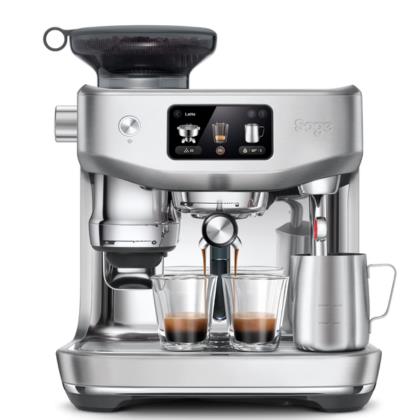
Get An EXTRA 12.5% off at SageCheck Price - Amazon
Best for Premium Features
If you’re willing to spend more for the ultimate in-between experience, the Sage Oracle Jet is the top dog. It takes everything the Barista Touch Impress offers and adds premium features like dual heaters, auto-milk steaming with precise temperature control, and a more polished interface. It’s for those who want the best of both worlds: pro-level coffee with minimal effort.
Features
- Dimensions: 39 cm wide × 40 cm deep × 43 cm tall
- Heater: Dual ThermoJet (espresso and steam)
- Grinder: Integrated Baratza European conical burrs
- Grind Settings: 45 stepped
- Portafilter: 58 mm stainless steel (single & double baskets, standard + pressurised)
- Milk System: Auto MilQ hands-free microfoam with 8 presets, plus manual frothing
- Espresso Workflow: Fully assisted dosing, tamping, and purge
- Menu Drinks: Espresso, Double Espresso, Americano, Latte, Flat White, Cappuccino, Cold Brew, Cold Espresso, Babyccino, Hot Chocolate, Tea
- Custom Drinks: 8 programmable slots
- Water Tank: 2.5 L, rear-accessed with a quick-release handle, includes a filter
- Drip Tray: Large capacity with hidden storage
- True Double Shots? Yes
- Maximum Cup Height: ~12 cm
My Observations
The Oracle Jet is Sage’s flagship in-between machine, and it shows. The dual ThermoJet heaters mean you can pull espresso and steam milk simultaneously, which is a big step up from the Barista Touch Impress. The auto MilQ system is next-level, letting you dial in exact milk temperatures and textures for everything from flat whites to cappuccinos. It’s still not a true bean-to-cup (no internal brewing unit), but it automates so much of the process that it feels close. The touchscreen is slick, and the addition of cold brew and cold espresso options makes it versatile for all coffee lovers.
What I Like
- Dual heaters: Espresso and milk steaming at the same time—proper barista workflow
- Auto MilQ: Precise milk temperature and texture control, almost as good as manual
- Cold options: Cold brew and cold espresso are genuinely useful additions
- Shot quality: As good as any prosumer espresso machine
- Build quality: Feels like a tank, in a good way
- Customisation: Tons of drink options and programmable slots
What I Like Less
- Price: It’s a big jump from the Barista Touch Impress
- Size: Takes up serious counter space
- Overkill for some: If you don’t need cold brew or simultaneous steaming, it’s a lot to pay
Final Verdict
The Sage Oracle Jet is the ultimate in-between machine for those who want top-tier espresso and milk drinks with maximum convenience. It’s not cheap, but if you’re after pro-level results without the pro-level effort, this is as good as it gets. Perfect for coffee enthusiasts who want to impress guests or just treat themselves daily.
| Test Results | Barista Touch Impress | Oracle Jet |
|---|---|---|
| Heat-up time (from cold) | ~10 seconds | ~10 seconds |
| Max coffee dose | Single 10g | double: 20g | Single 11g | double: 22g |
| Steam power (170ml, 0-60 °C) | ~40 seconds (post espresso) | ~35 seconds (simultaneous possible) |
| Hot water power (200 ml) | ~50 seconds | ~45 seconds |
| Max milk temperature | ~65 °C (auto), no limit (manual) | ~65 °C (auto), no limit (manual) |
| Coffee temperature | ~70 °C | ~72 °C |
| Hot water temperature | ~85 °C | ~85 °C |
| Noise: | Grinding ~65dB | Pump ~50 dB | Grinding ~65dB | Pump ~50 dB |
Best Fully-Automatic (One-Touch) Bean-to-Cup Coffee Machines
Option 1: Gaggia Accademia
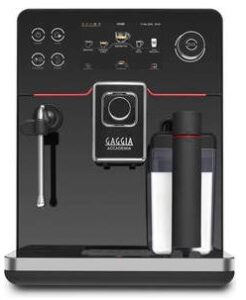
Check Price - Gaggia DirectCheck Price - Amazon
Best for Espresso Quality
If you’re after a true one-touch bean-to-cup machine that prioritizes espresso quality, the Gaggia Accademia is hard to beat. It’s designed for those who want a premium, hands-off experience with coffee that rivals traditional espresso machines. Gaggia’s focus on dose control and shot quality shines here.
Features
- Dimensions: 28 cm wide × 43 cm deep × 39 cm tall
- Heater: Dual boilers (espresso and steam)
- Water Tank: 1.6 litre, top-accessed
- Milk System: One-touch milk carafe with adjustable froth
- Grind Settings: 8
- Strength Settings: 5 (7-11g per shot)
- True Double Shots? Yes
- Grinder Bypass Chute for Pre-Ground Coffee? Yes
- Maximum Cup Height: 15 cm
- Grounds Bin Capacity: 16 coffees
My Observations
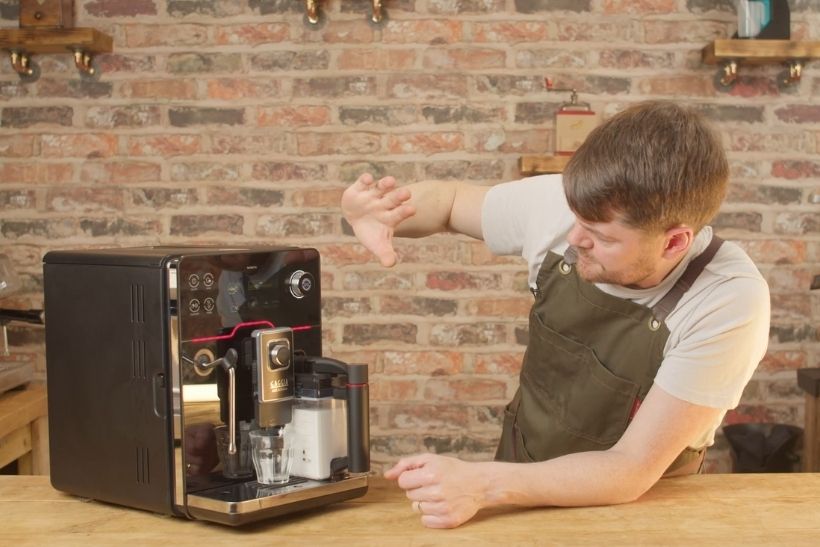
The Gaggia Accademia is a beast of a machine, built with a focus on delivering strong, customizable espresso with minimal effort. The dual boilers mean you can pull shots and steam milk simultaneously, which is rare for true bean-to-cup machines. The one-touch milk carafe is excellent, producing good microfoam for lattes and cappuccinos, and the dose control (up to 11g per shot, 22g for doubles) ensures intense espresso. The interface is straightforward, with tactile buttons and a small LCD, keeping things simple yet effective.
What I Like
- Dual boilers: Espresso and milk at the same time, no waiting
- Shot quality: Among the best for bean-to-cup, with precise dose control
- True double shots: Proper 22g doubles for strong espresso
- Milk carafe: Reliable and produces great foam for a one-touch system
- Build: Solid, premium feel, like it’ll last a decade
What I Like Less
- Price: It’s not cheap, but you get what you pay for
- Size: Takes up a fair bit of counter space
- Top-access tank: Can be awkward depending on your kitchen setup
Final Verdict
The Gaggia Accademia is the go-to for anyone who wants a fully-automatic bean-to-cup machine that doesn’t skimp on espresso quality. It’s ideal for espresso purists who still want the convenience of one-touch milk drinks. If you’re happy to spend a bit more for top-tier performance, this is a fantastic choice.
Option 2: De'Longhi Eletta Explore
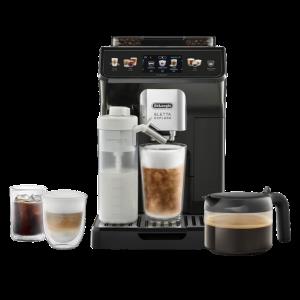
Get An EXTRA 10% off at De'LonghiCheck Price - Amazon
Best for Versatility
If you want a one-touch bean-to-cup machine that can do it all—hot drinks, cold drinks, milk-based, black coffees—the De’Longhi Eletta Explore is your machine. It’s packed with features and drink options, making it perfect for households with varied tastes.
Features
- Dimensions: 26 cm wide × 45 cm deep × 39 cm tall
- Heater: Thermoblock
- Water Tank: 2 litre, front-accessed
- Milk System: LatteCrema Hot and Cool carafes (hot and cold milk options)
- Grind Settings: 13
- Strength Settings: 5
- True Double Shots? Yes
- Grinder Bypass Chute for Pre-Ground Coffee? Yes
- Maximum Cup Height: 14 cm
- Grounds Bin Capacity: 14 coffees
My Observations
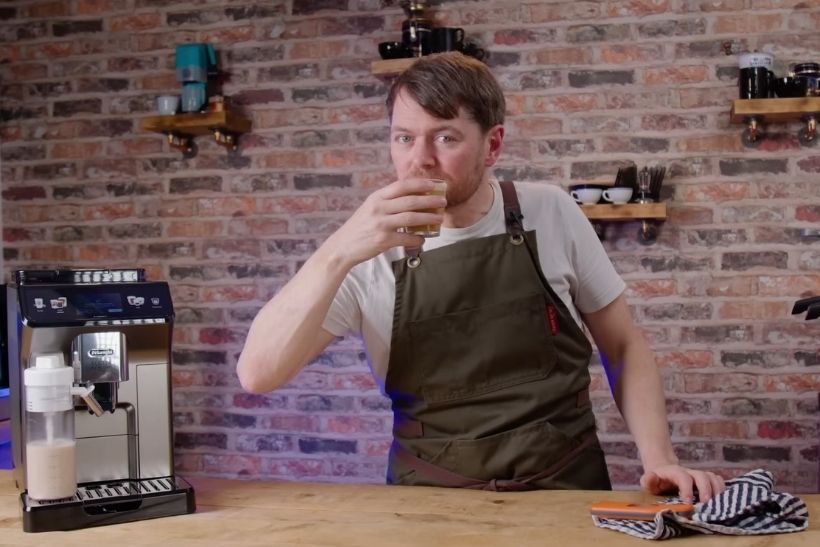
The Eletta Explore is De’Longhi’s answer to “what if we made a bean-to-cup that does everything?” It’s got an insane number of drink options—hot, cold, milk-based, black, you name it. The inclusion of the LatteCrema Cool carafe for proper iced coffee drinks sets it apart from most other bean-to-cup machines. The espresso is solid, though not quite as intense as the Gaggia Accademia, and the milk system is top-notch for both hot and cold drinks. The touchscreen interface is intuitive, and the front-access water tank is a nice touch.
What I Like
- Versatility: Hot and cold drinks, including proper iced coffees with the cool carafe
- Milk system: Hot and cold milk options with great texture
- Drink variety: Over 40 drink options, from espresso to iced cappuccino
- Interface: Touchscreen is easy to navigate
- Front-access tank: Super convenient for refills
What I Like Less
- Espresso intensity: Good, but not quite as strong as Gaggia’s Accademia
- Size: It’s a bit bulky for smaller kitchens
- Price: On the higher end for bean-to-cup machines
Final Verdict
The De’Longhi Eletta Explore is the ultimate one-touch bean-to-cup for versatility. If you want a machine that can handle everything from a morning espresso to an afternoon iced latte, this is it. It’s not the absolute best for espresso purists, but for a do-it-all machine, it’s unmatched.
| Test Results | Gaggia Accademia | De'Longhi Eletta Explore |
|---|---|---|
| Heat-up time (from cold) | ~35 seconds | ~40 seconds |
| Max coffee dose | Single 11g | double: 22g | Single 12g | double: 17g |
| Steam power (170ml, 0-60 °C) | ~40 seconds (simultaneous possible) | ~55 seconds |
| Hot water power (200 ml) | ~50 seconds | ~45 seconds |
| Max milk temperature | ~65 °C | ~67 °C (hot), ~10 °C (cold) |
| Coffee temperature | ~78 °C | ~80 °C |
| Hot water temperature | ~88 °C | ~80 °C |
| Noise: | Grinding ~65dB | Pump ~50 dB | Grinding ~62dB | Pump ~45 dB |
Honourable Mentions (Worth a Look)
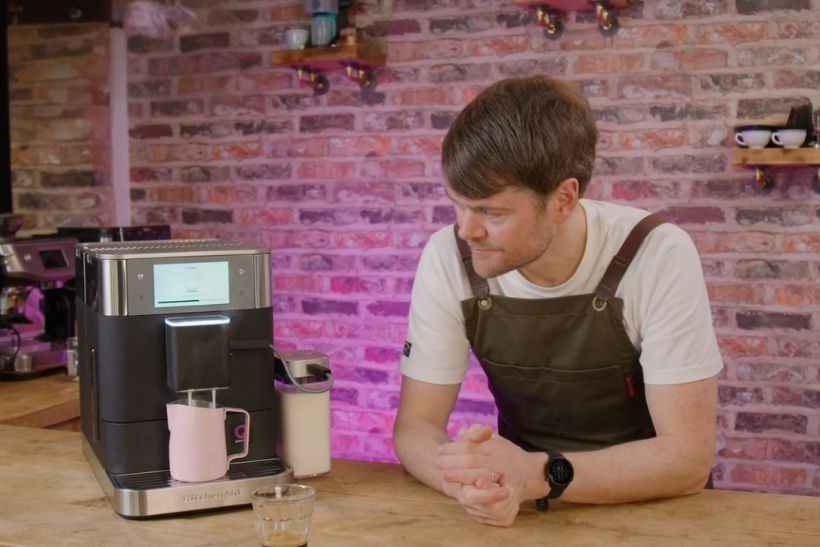
There are masses of other bean-to-cup machines I've not mentioned in this best of review, simply because there's too much choice & I wanted to narrow it down to two main options per category.
So here is a very quick run-down of other popular bean-to-cup machines, and what I think of them.
- Sage Oracle Dual Boiler: “In-between” traditional & bean-to-cup machine. Dual user mode is the standout feature (it's amazing!). Re-mortgage required
- Sage Barista Touch: Another “in-between”, but no real assistance on the espresso side, that's all manual
- Breville One Touch: Not a bean-to-cup, and not one-touch! Massively popular, but I wouldn't even use it as a door stop
- Breville Barista Max: Not even an in between, though some think it is. This is the “Breville UK” (nothing to do with Sage Appliances) version of the Barista Express
- Gaggia Brera: One of my favourites, very similar to the Anima in function, but 3 strength settings not 5 & front-fill water tank, and it's really short at just under 32cm
- Gaggia Magenta: One of Gaggia's new generation machines, similar to the Anima but with a more modern interface.
- Gaggia Cadorna: Another of Gaggia's newer machines, fancier interface, 4 user profiles
- DeLonghi Eletta Cappuccino: Very good machine for the money when it's on offer, often for around £450 – even less with a discount code.
- DeLonghi Magnifica Start: Halfway-house between the Magnifica S and the new Magnifica Evo range
- Siemens EQ6 plus S300: Reliable, workhorse machine, with a simple cappuccinatore frother. Great no-fuss option, though there are lots of options at this price.
- De'Longhi PrimaDonna Soul: Very nice, flashy machine, one of their flagships. Pricey, but sometimes available at around half the price with a discount code.
- De'Longhi PrimaDonna Aromatic: Their latest flagship, with some very impressive features and a potentially GREAT app (needs some tweaks).
- KitchenAid KF8: It won't help you with baking, but it's an impressive bean-to-cup machine, very quiet, and has some great features, including a removable hopper
How I Test Bean-to-Cup Coffee Machines
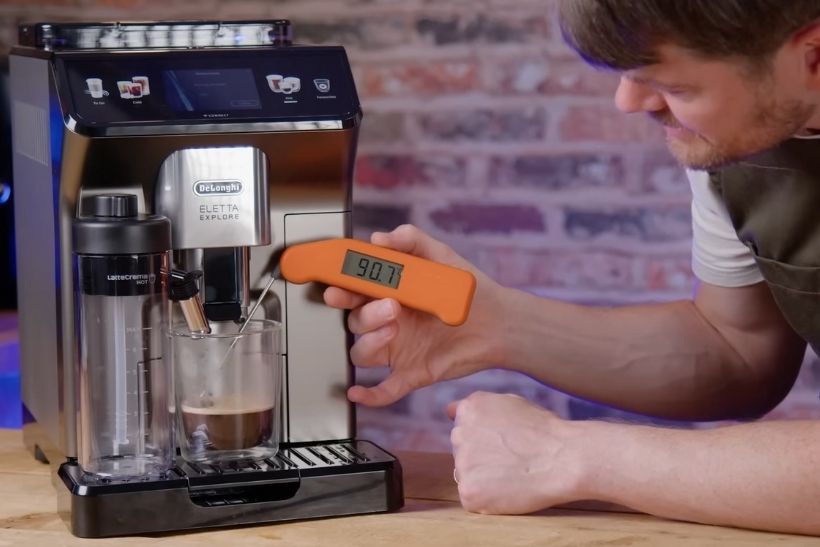
When I'm testing a coffee machine for review, I'll use that machine a LOT, in the run-up to reviewing the machine, taking notes as I go along.
I'll often use that machine as my daily driver for a while after the review, allowing me to gain more insights over time. I'll then weave these insights into my review posts and include them in a later update video, if the main video review was published in the meantime.
I always test the machines using the same coffee beans, if I'm doing side-by-side comparison reviews, and most of the time I use my no.1 favourite, cworks Chocolate Brownie Blend.
- Noise: I use a handheld digital decibel meter from a 1m distance.
- Espresso intensity: I don't trust my taste buds, so I also use the DI Fluid R2 refractometer, which produces a TDS reading.
- Steam Power: Always fridge-cold milk, 160ml, steamed to 60°C, cold jug
- Weights: I always use precise, calibrated scales, and the same scales for comparisons. (Usually Acaia Lunar or Bookoo)
- Temperatures: All temperatures are measured using a Thermapen 3 (accurate within ±0.4 ºC)
- Dimensions: I always measure machines myself; brands do have a habit of using wonky tape measures ;-), or accidentally using boxed dimensions
- Research: All observations are from my own hands-on testing & experience; when applicable, I'll also take long-term customer reviews on board for longer-term considerations.
Best Bean-to-Cup Coffee Machines FAQs
Q: What’s the Difference Between Bean-to-Cup Machines and Espresso Machines With Built-in Grinders?
A: What I'd refer to as a “true” bean-to-cup machine is an espresso machine with a built-in grinder AND a brewing unit, instead of a portafilter. An espresso machine with a built-in grinder, for example, the Sage Barista Express, is an espresso machine with an integrated grinder. To qualify as an actual “bean to cup” machine, it would need an internal brewing unit to take care of dosing, tamping, and internally ejecting the puck of used coffee.
Q: How Noisy Are Bean-to-Cup Machines?
A: Usually, the loudest sound from a bean-to-cup machine will either be the sound of the beans grinding, or the motor turning the gears in the brewing unit to tamp and then eject the used coffee internally, and usually these will be at around the high 60s to low 70s in Decibels.
This is similar to the noise of a hairdryer on full power, or to the follically challenged who can't remember that noise ;-), a similar level to modern vacuum cleaners. The loudest parts of the process tend to come in waves; it's not at the max volume continuously throughout coffee-making. Parts of the process, such as dispensing coffee and frothing milk, drop to around 40-50 dB.
Q: What's The Best Small Bean to Cup Coffee Machine?
A: I didn't include a separate category for compact or small bean-to-cup coffee machines, as there would be too much overlap given that some of the best machines in other categories are the same machines that would end up in the best compact bean-to-cup coffee machine category.
When it comes to “small”, though, it's important to clarify whether you mean footprint or height, or both, and also the kind of machine you're looking for. Personally, I'd recommend focusing on the type of machine you're looking for, your favourite drinks, your budget, and then simply look at the dimensions (I actually measure them, so you can trust my dimensions) to check your chosen machine fits the available space.
Q: Do Pricer Options Make Better Coffee Than Budget Bean-to-Cup Coffee Machines?
A: Not necessarily, and this will probably come as a surprise to many people, as you'd naturally expect that budget bean-to-cup coffee machines would be cheaper because they don't make coffee that tastes as good as more expensive machines.
Most bean-to-cup coffee machines are virtually the same internally, from very low-cost budget models to much more premium options. There are subtle differences, but most of the time when you spend more, you're investing more in features, and sometimes in more premium materials, rather than in better coffee quality.
Q: Are One-Touch Milk Systems as Good as Manual Steam Wands?
A: It depends on the machine in question. Many earlier one-touch milk machines struggled with both texture and temperature, producing only stiff milk froth that was often “warm”, rather than hot. The latest one-touch machines usually do better on both fronts, though if you like particularly hot milkies, you'd be better off with a steam wand for total control over milk temperature.
Q: How Often Should I Clean the Brew Unit & Milk System?
A: For the milk system, it's good practice to rinse after each use, or at least after the last coffee in each coffee-making session. For the brewing unit, most machines feature easily removable brewing units that can simply be rinsed under a tap, and most brands tend to suggest doing this on a weekly basis. Deeper cleans of the brewing unit are usually recommended monthly.
Q: Why Don't You List The Best Bean to Cup Coffee Machine Under £100
A: The reason I've not included a category for best bean-to-cup coffee machines under £100, or under £200 either, is that there aren't currently any bean-to-cup coffee machines under £200, at the time of writing. If you mean “bean to cup filter coffee machines”, then what you're looking for is a “grind & brew” machine, and you will find many grind and brew machines under £200, and under £100.
For example, the Russell Hobbs Chester Grind & Brew is well under £100, and is one of the best-selling “bean to cup filter coffee machines” in the UK.
Q: What About The Best Bean to Cup Coffee Machine For Office Use?
A: If you're looking for a bean-to-cup coffee machine for office use, it really depends on the size of the office and how many people will be using it, but this post is about home coffee machines, which are my specialty. There is some crossover; home bean-to-cup machines that are suitable for smaller office use.
The most obvious would be the Gaggia Accademia, which I've heard has been used in almost commercial settings for quite some time without issues. Jura coffee machines are also popular for office use, though they offer bean-to-cup models specifically designed for the office.
The post Best Bean to Cup Coffee Machine UK: Real Tests, No Hype appeared first on Coffee Blog.
By: KevTitle: Best Bean to Cup Coffee Machine UK: Real Tests, No Hype
Sourced From: coffeeblog.co.uk/best-bean-to-cup-coffee-machines/
Published Date: Fri, 01 Jan 2021 14:24:30 +0000

